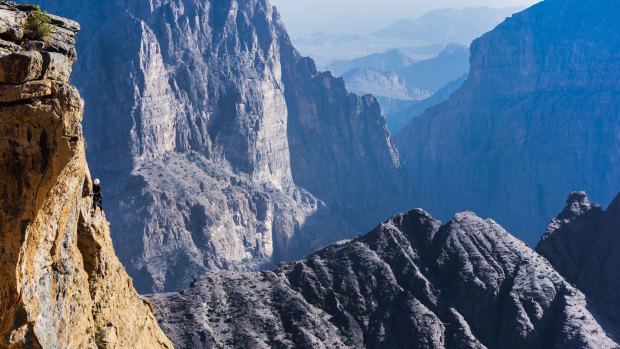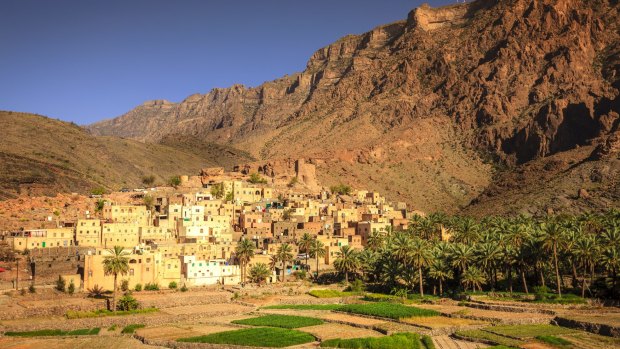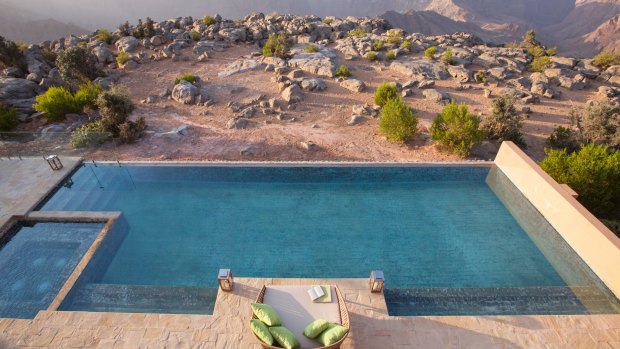This was published 6 years ago
Shicer Wubar, the 'lost city' and other adventures in Oman
By Daniel Scott

Rock climbing in the Al Hajar Mountains.
Hanging by a thread, at the edge of a yawning canyon in the Hajar mountains, it is hard to envisage Prince Charles and Princess Diana, relaxing nearby, away from the media spotlight, during a 1986 visit to Oman.
Yet, if I could look up from the climbing wall across which I am now dangling, I could see what's known as Diana's Point poking out from the Saiq plateau, 2000-metres above sea level. I could imagine the Prince painting the view while Diana read, the scent of damask roses filling their regal nostrils and royal mutterings occasionally passing their lips.
Instead, I'm suspended off a 20-metre climbing wall in Oman's highest mountain range, putting my trust in the cable I'm attached to. That, and my two adventure guides from the Anantara Al Jabal Al Akhdar resort above, who rigged it up.

The village of Bilad Sayt in the Al Hajar Mountains.Credit: Shutterstock
Having managed abseiling down the wall – the hardest part of which was stepping backwards off the edge and into thin air – I'm now tasked with clambering back up.
Surveying the wall from beneath is like sizing up the side of a small apartment block.
There is nothing for it but to begin picking my way up, sliding between hand and foot holds in the sheer rock-face,

The new Anantara Al Jabal Al Akhdar, in the Hajar mountains, Oman.
I'm a third of the way up when I lose my grip. I feel myself falling and anticipate a heavy landing seven metres below. The rope happily holds fast and I swing right across the wall.
"You're OK," comes a voice from above.
"Pull yourself back across," comes another from below.
I search for anything to get a hand or foot onto.
Finally, I find a narrow crevice above me, grasping it by my fingertips, while trying to dig my right foot into a ledge below.
My foot misses and I scrape away flesh on my shin.
"Nearly back on track," encourages Anantara mountain guru, Maher, from above, "left foot onto that lip".
Scraping more flesh off my left knee – note to self, wear long pants next time – I reach the foothold and am able to continue my ascent.
Two minutes later I am somehow near the summit, propelled by trembling arms and increasingly jellied legs.
"Smile for the camera," says Maher, as an improbable yoga stretch takes me to the top, "you made it!"
My beam reflects both my relief and incredulity at having accomplished my first mountain climb at an age when I could be a grandfather.
My close acquaintance with the Hajar mountains comes at the beginning of a week of Omani adventures, centred on the north and deep south of this country on the edge of the Arabian peninsula.
My first few days are all rock and roll, as I follow up my climbing experience with a dive trip in the Dimanayat Islands, a 45-minute boat ride from the capital Muscat.
Comprising nine islands spread over seven kilometres in the Gulf of Oman, the group is covered by the Al-Dimaniyat Nature Reserve and encompasses 22 dive sites.
Between November and February, camping is permissible in the reserve, and Nasser Al Khanjari, owner of Muscat-based Mantra Dive, has arranged for us to overnight on an island beach.
This turns out to be the highlight of our trip, as I get the chance to chat around the campfire with three Omanis – Nasser and his offsider Havel, and another diver, Hamed – and to sleep under the Middle Eastern stars.
Nasser, whose day job is as an engineer in the oil industry, is a generous host, laying on spicy chicken rolls and grilled steak for dinner and a breakfast of beef bacon and eggs in pita bread.
While whale sharks and nesting turtles are a feature of the islands during the summer, in late winter, when we are here, algae blooms in the flat, calm sea make visibility an issue.
Nonetheless, with 70 per cent of the islands covered in reef, there is still plenty to see and our first dive, on a mid-ocean mound called the Aquarium, is marked by getting close to several loved-up cuttlefish couples, dancing in unison, and to a huge honeycombed moray eel.
Like our own Barrier Reef, the corals here are suffering from an onslaught by crown of thorns starfish. However, there are still swathes of healthy soft coral at sites like the "police run-off" beside Al Kabeer (Big Mountain Island) and among them, we spot several sizeable lobsters and a green turtle.
Next morning, I rise at dawn and watch the sun rise over the gulf, feeling fortunate to have visited a part of Oman tourists rarely see.
A few days later, I find myself heading into an entirely different landscape for another overnight trip, this time in the Rub Al Kahli, or the Empty Quarter desert.
I'm with local guide Suhail Al Mahri, a former Bedouin, and we are driving into this 650,000-square-kilometre desert, through the mountains behind the coastal city of Salalah, close to Yemen border, in southern Oman.
"This is where I was born," says Suhail as we wind through the rocky hills, "and lived until I was eight."
"I took wood to the market to sell," continues Suhail, "and my father ran camels to transport sardines."
"Camels were used like lorries in those days," he adds, as we pass a herd of about 20 dawdling by the roadside.
Nowadays, Suhail has exchanged camels for a Landcruiser and shares his former desert home with visitors from around the world.
Our first stop is at a lone wild Boswellia tree.
These trees are the source of the world's finest frankincense, once worth as much as gold.
It was this resin that made Oman an ancient maritime super-power, forging trade routes across the world.
Although famous as a scent, frankincense is also reputed to have remarkable therapeutic properties.
"Frankincense can cure stomach troubles and help with aching joints," says Suhail, cutting a tear in the tree's trunk, a milky white sap running from the scar.
Next we visit Shicer Wubar, discovered by a satellite in 1992 and said to have been a frankincense trading post, dating to the 4th century.
On this late winter afternoon, I have "the lost city" to myself.
After leaving the road and bumping across the lumpy desert for another hour, we arrive at a point where the dunes dip and rise like swells on the open sea.
We edge around a big mound of golden sand, and Suhail stops the vehicle in a dip between low-lying ridges.
As Suhail sets a fire going on the sand and begins preparing dinner, I climb the nearest dune to photograph the sunset.
From the top, I survey a constantly evolving panorama of breeze-swept sand, shaped into beige curves and velvety contours that grow darker as the sun drops. I watch as rivulets of sand whisper across nearby ridges in the dying breeze and look down on Suhail, on his knees in the foothills below, offering his evening prayer towards Mecca.
Omanis, as I discovered on the dive trip, are famously hospitable and Suhail has brought enough provisions to feed a royal cortege. We tuck into a tasty home-made camel stew with vegetables and rice and talk long into the night.
Although Suhail has brought a tent for me to sleep in, I opt instead to sleep outside on a rug, the soft sand providing my mattress and the Arabian night sky my ceiling.
It's the sort of desert adventure that captured the imagination of early 20th century travel writers like Freya Stark and Wilfred Thesiger, who loved the Arabian peninsula.
Although I've spent most of my nights here in super-luxurious accommodation at two new Anantara properties, and loved it, sleeping in the dunes of Empty Quarter, and rising before dawn, to witness another transformative sun rise, caps off an adventurous week in Oman.
TRIP NOTES
MORE
FLY
Qatar Airways fly daily from Sydney to Doha with onward connections to Muscat. Flight time around 16 hours total. Qatarairways.com
STAY
Climbing and abseiling is one of the activities available to guests staying at the new Anantara Al Jabal Al Akhdar, in the Hajar mountains, two hours' drive from Muscat. Rooms from $704 per night. Jabal-akhdar.anantara.com
TOUR
Empty Quarter tours are available through the new Anantara Salalah resort, beside the Arabian sea, on Oman's south coast. Rooms from $512. Salalah.anantara.com
To book diving off Oman contact Adventure World: Adventureworld.com/oman
Daniel Scott travelled as a guest of Oman Tourism and Anantara Hotels.
Sign up for the Traveller Deals newsletter
Get exclusive travel deals delivered straight to your inbox. Sign up now.